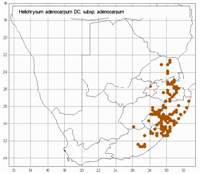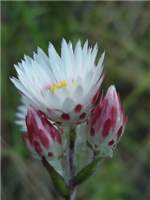 |
_sml.jpg) Photo: L. Fish |
_sml.jpg) Photo: L. Fish |
_sml.jpg) Photo: L. Fish |
 Photo: L. Fish |
Photo: P.M. Burgoyne |
 Photo: H. Heilgendorff |
Common names:
Pink everlasting, Pink sewejaartjie, rooi sewejaartjie (A)
Origin of name:
aden = a gland + karpos / carpum = a fruit / fruits
adenocarpum = glandular fruits
Diagnostic characters:
Woolly plant with basal leaf rosettes
Large solitary heads
Shiny white bracts, mostly with red tips
Description:
Perennial herb, stock woody, crowned with 1�several leaf rosettes, flowering stems 1�10, lateral, decumbent or erect, 40�450 mm long, simple or forking above into a few- to many-headed very open corymb, glandular-pubescent or woolly, closely leafy. Radical leaves sub-orbicular to elliptic-oblong, prostrate, 20�40 (�140) x 15�25 (�40) mm, mostly loosely grey-woolly or cobwebby, sometimes only glandular-pubescent; cauline leaves oblong to lanceolate, smaller than the radical and passing into inflorescence bracts, woolly, cobwebby or glandular-pubescent, often without wool when the radical leaves are woolly. Heads heterogamous, campanulate, 15�20 mm long, c. 25�35 mm across the radiating bracts. Involucral bracts in 9�11 series, graded, loosely imbricate, much exceeding the flowers, glossy, acute, white, or white tipped rose, crimson or scarlet, or wholly rose or crimson. Flowers c. 165�520, 20�90 female, 145�500 homogamous, yellow often tipped red. Achenes 0,75 mm long, barrel-shaped, with myxogenic duplex hairs. Pappus bristles several, barbellate to subplumose in upper part, bases nude, not cohering.
Flowering mainly between January and April.
Distribution:
Found in open grassland, often on moist slopes or in moist depressions from sea level to c. 3 000 m. Very small plants (to 50 mm tall) are found in alpine grassland. Widespread, from the Soutpansberg south through the highlands of Mpumalanga and Swaziland to the mountainous NE. corner of the Free State, Lesotho, KwaZulu-Natal and Eastern Cape as far as the Amatola Mountains. Also in the E. highlands of Zimbabwe and neighbouring Mozambique.
Savanna, Grassland and Thicket Biomes.
Notes:
H. adenocarpum is frequently confused with H. monticola but is easily distinguished by its lateral, not terminal, flowering stems. Herbarium specimens are often miss-identified when basal parts are not present.
A very showy plant, that is often collected.
The heads are always c. 15�20 mm long, but there is much variation in stature, leaf size and indumentum, number of heads on the flowering stem, and colour of the involucral bracts. Plants with 1-headed stems are common above c. 1 200 m, those with many-headed stems from sea-level to c. 1 800 m, but there are many exceptions. Plants with pure white bracts have been recorded only below c. 600 m and grow mixed with plants with parti-coloured bracts.
Devenish 1396, a less hairy-leaved specimen is reported to have a strong �foetid� odour.
Two subspecies are recognized:
Radical leaves cobwebby or woolly, involucral bracts ranging from crimson to scarlet or pink, or these colours on white, or rarely pure white and then growing with plants with parti-coloured bracts
(a) subsp. adenocarpum
Radical leaves glandular, very rarely cobwebby or woolly, involucral bracts always pure white
(b) subsp. ammophilum
Taxonomy:
Literature:
Helichrysum adenocarpum DC. Prodr. 6: 180 (1838); Harv. in F.C. 3: 229 (1865); Moeser in Bot. Jb. 44: 335 (1910); Batten & Bokelmann, Wild. Flow. E. Cape Prov. 156, plate 125,2 (1966); Compton, Fl. Swaziland 627 (1976); Hilliard, Compositae in Natal 239 (1977).
Type:
KwaZulu-Natal, Port Natal [Durban], Dr�ge 5019 (G-DC, holo.; E; K; SAM, iso.).
Synonym(s):
Gnaphalium adenocarpum (DC.) Sch. Bip. in Bot. Ztg 3:170 (1845).
Vouchers:
Codd 2777 (NU; PRE);Compton 25808 (PRE); Hilliard 8088 (E; K; M; MO; NU; S); Hilliard & Burtt 6584 (E; K; MO; NU; PRE); Brusse 5021 (PRE).